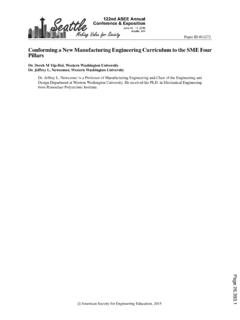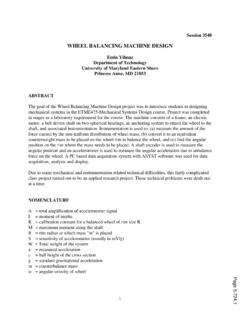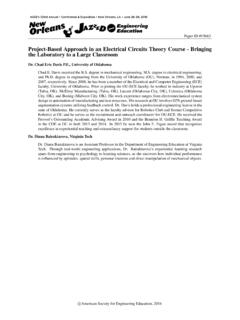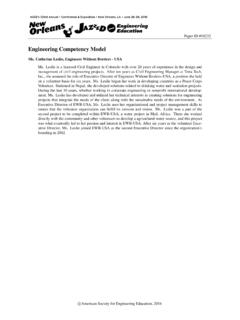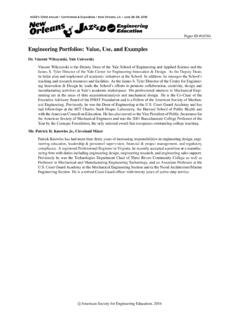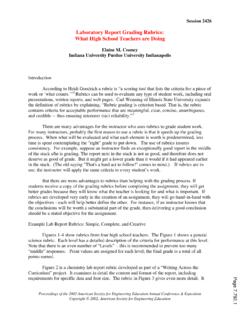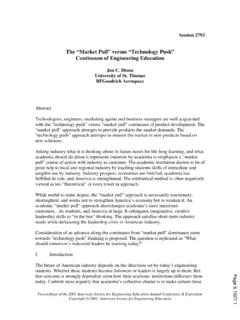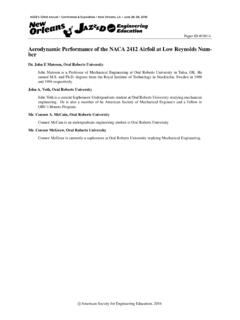Transcription of A Project Based Introduction To The Finite Element Method
1 Session 2520A Project - Based Introduction to the Finite Element Miner, LinkUnited States Naval AcademyAbstractAll mechanical engineering majors at the Naval Academy are required to take a course in Com-puter Aided Design during their senior year. The underlying philosophy of the course is to intro-duce students to computer Based solution techniques that are currently used in engineeringpractice. To emphasize the utility of the computer the problems selected for solution are ones thatwould be difficult to solve by hand. In particular, students are introduced to the Finite elementmethod through a Project requiring the design of a bracket that must meet size, load, and deflec-tion requirements. In addition, the strength to weight ratio of the bracket is to be optimized.
2 Thestudents are given a brief Introduction to the fundamentals of the Finite Element Method , includingbasic theory and practical guidelines for modeling. Then design teams are formed to design andbuild the brackets. The brackets are tested to check the performance against the design require-ments, to compare the teams predicted results to actual performance, and to see which teamachieves the highest strength to weight ratio. The IDEAS software package is used to generate thegeometry of the bracket and to perform the Finite Element analysis. Design teams have developedbrackets with strength to weight ratios of 6000 and have been able to predict failure loads to with10% of the measured value. This Project - Based approach to the Finite Element Method gives thestudents an appreciation for how powerful the Method can be in performing structural IntroductionThe past twenty years has seen a rapid advancement in the capability of computer-aided designtools.
3 Commercial software packages are readily available to assist with all phases of the designprocess from ideation through synthesis and analysis, detail design and testing to prototype andproduction. Computer-aided design tools have become an essential part of the modern design andmanufacturing environment and engineering curricula has evolved to include instruction in thisfield. Virtually all engineering schools include instruction in computer-aided design to someextent. Design software has become so powerful that a novice can conduct sophisticated analyseswithout knowing very much about the details or limitations of the analysis it is important for engineering schools to educate students about the use of computer-aideddesign tools, they must also ensure that the students have a basic understanding of the underlyingprinciples upon which these computer programs are Based .
4 Striking a balance between teachingthe fundamentals and giving the students hands-on experience with the technology continues to bea challenge. The real benefit in introducing the students to the technology is the ability to solvemore interesting, physically realistic problems in a short amount of Mechanical Engineering students at the Naval Academy are required to take a course in com-puter-aided design in the fall semester of their senior year. Roughly one quarter of the course isPage to introducing the Finite Element Method . Students use the Finite Element Method to com-plete a Project requiring the design of a bracket that must meet size, load, and deflection require-ments. In addition, the strength to weight ratio of the bracket is to be optimized. The objective ofthis paper is to illustrate how a Project - Based Introduction to the Finite Element Method using acommercial software package, SDRC I-DEAS, provides a basic Introduction to the theory, as wellas, a meaningful experience using the is important for the student to have a basic understanding of the Finite Element Method , other-wise it can be difficult to evaluate the results that the commercial packages produce.
5 By under-standing the basic approach of the modeling, the student can make a more informed interpretationof the results to decide if they make sense. All too often, students and professionals alike, readilyaccept the results generated by the computer without casting a critical eye at the U. S. Naval Academy the Computer-Aided Design course is heavily oriented towards teamdesign projects. The lectures are organized to develop the new material the students will need tolearn, in a logical manner that parallels their use of the software in the laboratory portion of thecourse. Ample time is provided once the new material has been presented to allow the students toapply it to their projects. In addition, a few short lab exercises and a homework assignments aregiven to reinforce the concepts developed in the Basic TheoryAs an Introduction to the Finite Element Method the students are given a set of notes1 ( ~ , ~ ) that are covered duringtwo lectures.
6 The following six major steps in the Finite Element process are emphasized:Step 1. Establish Governing Equations and Boundary order to generate a valid approximate solution to a problem, the differential equation that gov-erns the behavior and the corresponding boundary conditions for the problem must be this is done the appropriate Finite Element formulation can be used to generate the 2. Divide Solution Domain into this step the entire solution domain is subdivided into small elements . Care is taken to makesure that enough elements are included to capture the behavior of the solution over the entiredomain. Areas of particular interest and care are locations where critical values are expected,locations with large gradients, locations where the geometry changes suddenly, locations whereboundary conditions and loads are applied.
7 Typically, the larger the number of elements the betterthe approximation of the solution to the differential Element the elements are formed, the algebraic equations to be solved are developed for each indi-vidual Element . The form of the algebraic equations for every Element will be the same. Differ-ences from one Element to the next will be due to changes in Element size and properties. This isthe power of the Finite Element Method , the equations can be written once for a general elementthen they only need to be modified to reflect a particular elements geometry and 4. Assemble Global all the Element equations are generated they are put together to form a system of equationsfor the entire solution 5. Solution of Global system of equations is solved for the value of the dependent variable in the original differen-tial equation at discreet points throughout the solution domain.
8 Depending on the problem typethere may be hundreds, thousands, tens of thousands, or even hundreds of thousands of points atwhich the solution to the differential equation is 6. Solution accuracy of the solution must be verified before the results can be considered valid. One wayto do this is to refine the mesh (increase the number of elements ) and rerun the solution. If thevalue of the dependent variable at the discreet points in the mesh does not change significantly asthe mesh is refined, the solution is deemed to be a means of illustrating the Finite Element Method , the six steps are related to the analysis of anaxially loaded bar. Figure 1 shows the bar and the boundary conditions used and figure 2 showsthe corresponding Finite Element representation.
9 The desired results are the displacement andstress distribution along the length of the bar. This example is convenient because it allows all thesteps of the modeling process to be demonstrated, derivation of Element equations, calculation ofelement matrices, assembly of the global equations, contributions of multiple elements to a nodalequation, solution of the global equations, and comparison to the exact solution. After coveringthis material in lecture the students are given a similar problem for homework that reinforces theconcepts from the lecture. They are asked to determine the displacement, strain, stress, and forcein an axisymmetric rod with a known displacement at the free end. They generate and solve byhand a three Element model. They also derive the exact solution to the governing equation andcompare the Finite Element results for displacement and stress to the exact they are covering the basic theory of the Finite Element Method in the lecture, the studentsare getting hands-on exposure to Finite Element modeling software in the laboratory.
10 During twolaboratory periods the students complete workshops 11A through 11C in the IDEAS StudentGuide2, which introduces them to meshing, boundary conditions, solutions and post 1 500 lbAluminum Rod, E=10 X 106 psiFigure 1 Axially Loaded RodPage Bracket Design ProjectThe culmination of the this brief Introduction to the Finite Element Method is the design and test-ing of an optimized support bracket. The Project description is:EM477 Computer-Aided Design, Fall 1998 Finite Element Analysis Design ProjectIntroduction: A top secret program is underway to develop the next generation fighter reduction of all structural components is a key issue in this design. Every ounce of mate-rial should be used to its fullest extent to maximize the payload carrying capacity of the designers have spared no expense in achieving this goal.


